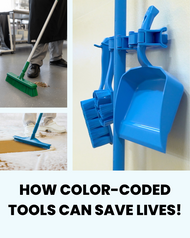Posted by Patricia Gerbis on 15th Aug 2023
CDC estimates that each year roughly 1 in 6 Americans (or 48 million people) gets sick, 128,000 are hospitalized, and 3,000 die of foodborne diseases.
Color-coded tools in the food industry provide visual guidelines for maintaining hygiene and minimize the risks of food borne illness and cross contamination during food processing. There are a variety of different methods for color coding cleaning plans. Using color-coded tools to separate processes, zones, shifts or allergens in food production areas minimize the chance of cross contamination. As a best practice, tools used in a food processing area should be color-coded based on a risk-based cleaning and sanitation plan.
We spoke with Vikan’s environmental health and sanitation manager, Amit M. Kheradia, for insight into how color-coded tools have changed the food processing industry for the better! With over 18 years of experience in food safety and multiple certifications in food safety regulation and preventative Controls, Amit helped us to better understand the imperative role that color-coded cleaning plans play in the food processing industry! (More on Amit’s qualifications & credentials: Amit M. Kheradia earns prestigious NEHA sanitation certificate)
The use of color-coded tools in the food processing has widely become an adopted best-practice! Over the past 50 years, there have been several changes to global food standards that have led to the increased use of color-coded cleaning systems in food processing facilities.
“Wide adoption of the color-coding concept in industry settings can be significantly linked to the passage of the 1970 US occupational health and safety act, where the worker-related agency recognized the need for standardized color-coding to improve safety and hazards communication in industrial environments.”, explains Amit, “Then, during the 1990s, Vikan became pioneers in the color-coding of cleaning tools used in food processing environments worldwide, where hygiene and sanitation are critical.”
In 1997, The National Advisory Committee on Microbiological Criteria for Food recommended guidelines for the HACCP (Hazard Analysis and Critical Control Point) principles. HACCP is a management system in which food safety is addressed through the analysis and control of biological, chemical, and physical hazards from raw material production, procurement, and handling, to manufacturing, distribution and consumption of the finished product. The use of color-coded tools and color-coding plans can become an integral part of a successful HACCP that helps minimize the risk of food product cross-contamination from micro-organisms, allergens, chemicals, foreign bodies, and food residues. It works by assigning cleaning tools a color for use in specific areas or for specific tasks.
A color-coded cleaning plan fits seamlessly with the 5S system. The 5S System is a methodology that focuses on workplace organization and cleanliness. The five S's stand for Sort, Set in Order, Shine, Standardize, and Sustain. The 5S system simplifies organization, ensuring only the essential tools are on hand, minimizing clutter and potential contamination risks. (Learn More: Using the 5S System for Color Coded Cleaning - Unisan Direct)
In general, color-coded tools contribute to maintaining a high level of hygiene, minimizing foodborne illness, and promoting the overall safety of food products in processing facilities by overcoming the following key challenges:
~ Microbial (Pathogen) Cross Contamination: Thisposes a significant threat to food safety. Color-coded tools can be employed to separate tools used for raw and cooked foods or different food groups, reducing the potential for pathogen transmission.
~ Allergen Cross Contact: Accidental mix-up of priority allergens may have severe consequences for consumers and employees with food allergies. Color-coded tools can be used to designate specific tools for handling allergenic ingredients, reducing the likelihood of accidental exposure to allergens during food processing.
~ Foreign Body Cross Contamination: Foreign body contamination is a common concern in the food industry. Color-coded tools can help minimize this risk by designating contrasting tools for food products. Specific tools can be allocated for specific areas, thus preventing tools used in non-food areas from encountering food products.
The future for color-coded tools is promising, especially now that "food safety culture" is a significant aspect of Global Food Safety Initiative (GFSI) benchmarked schemes such as BRCGS, FSSC 22000, and SQF global food safety standards. “A good number of companies are increasingly adopting color-coding programs and educating, training and regularly updating their companies on how to efficiently use fully colored tools to enhance tool identification and to effectively ensure contamination prevention,”, says Amit M. Kheradia.
Color-coded tools have revolutionized food processing facilities' hygiene and safety standards. With regulatory guidelines, the implementation of color-coded cleaning systems has become a standard practice in the industry. By addressing various sanitation challenges and enforcing preventative controls, color-coded tools have been a critical part of assuring food safety compliance. Embracing color-coded tools is an excellent way to prioritize hygiene, prevent cross-contamination, and provide high-quality food products.
In summary, the following general tips are recommended for sites using color-coded tools and color-coded plans:
1. Keep the plan simple: If possible, use only 3-5 colors and always use fully colored tools to avoid confusion.
2. Communicate: Employees need to be educated, trained, and refreshed on why a certain color-coding scheme has been adopted, and what, where, when, and how tools are to be used.
3. Review the plan: As a best practice, conduct a deep dive into your color-coding program annually, at minimum, or when there are significant changes in processing, layout, or employees’ expectations.
Implementing color-coded tools is an excellent way to prioritize sanitation and hygiene and prevent cross-contamination. The color-coded cleaning and material handling tools are currently available in up to 12 colors: lime green, green, pink, black, purple, red, orange, yellow, white, blue, grey, and brown.
To browse all Color Coded Tools visit Color Coded Tools - Unisan Direct or Vikan.com
Resources:
HACCP Principles & Application Guidelines | FDA
5S_Food_Industry_EN (ipaper.io)
HACCP Planning for Food Safety (ipaper.io)
